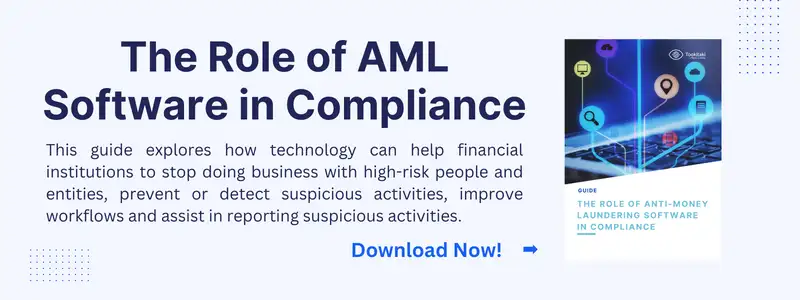A Guide to AML Compliance Software for Financial Institutions
In the complex world of financial crime, money laundering remains a persistent challenge. It's a sophisticated crime that requires equally sophisticated tools to combat.
Enter money laundering software. This advanced technology is a game-changer for financial institutions, providing them with the means to detect and prevent illicit activities.
These software solutions are designed to monitor transactions in real time. They identify suspicious patterns that may indicate money laundering, helping institutions to act swiftly and effectively.
But the landscape of financial crime is ever-evolving. As such, staying updated on the latest advancements in money laundering software is crucial for financial crime investigators.
This article aims to provide comprehensive insights into the latest trends and technologies in this field. It will explore how these tools can enhance investigative techniques and strategies, with a focus on practical applications and real-world examples.
So, whether you're a seasoned investigator or new to the field, let's delve into the world of money laundering software.
The Role of AML Compliance Software Solutions in Financial Institutions
In financial institutions, money laundering software plays a critical role. It serves as the first line of defense against illicit financial activities.
The software enables institutions to comply with AML regulations effectively, avoiding severe penalties and reputational damage. Compliance is not just a regulatory requirement; it's a cornerstone of sustainable operations.
Moreover, these solutions help institutions maintain customer trust. By preventing money laundering, financial institutions demonstrate their commitment to integrity.
Money laundering software also assists in managing and mitigating risk. Through real-time monitoring, it identifies high-risk transactions and customers, enabling swift action.
Ultimately, this software helps create a safer financial ecosystem. It empowers institutions to protect themselves and their clients from the threats posed by financial crime.
Key Features of Effective Anti Money Laundering Solutions
Effective anti-money laundering (AML) solutions come equipped with several key features. These features ensure thorough detection and prevention of suspicious activities.
-
Real-Time Monitoring: Continuous transaction tracking allows for immediate detection of potential money laundering activities. It ensures swift corrective actions.
-
Machine Learning Algorithms: These algorithms improve detection accuracy by learning from past transaction patterns. They adapt to new laundering tactics over time.
-
Risk-Based Approach: AML solutions prioritize resources based on the risk level of customers and transactions. This approach enhances efficiency and focus.
-
Reducing False Positives: By fine-tuning detection parameters, these solutions minimize legitimate transactions being flagged as suspicious.
-
Enhanced Due Diligence: High-risk customer activities undergo detailed scrutiny. This involves gathering more comprehensive information for accurate risk assessments.
-
Adverse Media Screening: This feature checks for negative news or reports about high-risk customers. It helps identify individuals linked to financial crime.
AML software should also offer seamless integration with existing financial systems. It ensures a comprehensive monitoring process, maintaining workflow continuity. User-friendly interfaces facilitate efficient navigation and quick decision-making by analysts.
Ultimately, AML solutions aim to create a multi-faceted defense strategy. This combines technology, processes, and personnel for optimal financial crime prevention.
Top AML Compliance Solutions in the Market
1. Tookitaki
Tookitaki's FinCense stands out as a superior AML compliance solution due to its innovative Anti-Financial Crime (AFC) ecosystem. FinCense leverages the AFC Ecosystem's extensive and continuously updated typology library to offer superior and comprehensive protection from financial crimes. It integrates seamlessly with existing financial systems, offering unparalleled data quality and integration capabilities.
Key Features and Benefits:
- Unparallel Fraud Prevention: Tookitaki's AFC Ecosystem-driven approach prevents transaction fraud in real time, protecting financial institutions' reputations.
- Comprehensive Risk Management: The AFC ecosystem covers all aspects of financial crime compliance, providing 100% risk coverage.
- Real-time Monitoring: Tookitaki offers real-time transaction monitoring, ensuring that suspicious activities are flagged and addressed promptly.
- Seamless Integration: The solution integrates easily with other systems, providing a holistic view of customer activities and potential risks.
2. ComplyAdvantage
ComplyAdvantage provides an AI-driven solution that helps financial institutions detect and mitigate financial crime risks. Its robust features include customer screening, adverse media screening, and transaction monitoring. ComplyAdvantage's platform is designed to reduce false positives and streamline compliance processes.
Key Features:
- AI-powered Risk Detection: Uses machine learning to identify and prioritize risks.
- Real-time Data Updates: Provides system-wide updates based on global watchlists and sanctions lists.
- Integrated Case Management: Allows for efficient management of compliance cases and alerts.
3. NICE Actimize
NICE Actimize offers a comprehensive suite of AML compliance tools designed to prevent financial crimes. The solution includes real-time fraud prevention, AML, and risk management features. It is known for its robust analytics and real-time monitoring capabilities.
Key Features:
- Real-time Fraud Prevention: Detects and prevents fraudulent activities in real time.
- Advanced Analytics: Provides deep insights into potential risks through advanced analytics.
- Integrated Risk Management: Offers a unified approach to managing financial crime risks across different channels and products.
4. SAS
SAS provides advanced AML compliance solutions with a focus on predictive analytics and business intelligence. Its software helps financial institutions detect and prevent money laundering activities by analyzing large volumes of data in real time.
Key Features:
- Predictive Analytics: Utilizes advanced analytics to predict and prevent potential financial crimes.
- Real-time Monitoring: Monitors transactions in real time to identify suspicious activities.
- Comprehensive Data Integration: Integrates data from various sources to provide a complete view of financial activities.
5. Oracle
Oracle's AML compliance solutions offer a range of features designed to help financial institutions comply with regulatory requirements and prevent financial crimes. The platform is known for its scalability and integration capabilities, making it suitable for large and complex financial organisations.
Key Features:
- Scalability: Can handle large volumes of transactions and scale with the growth of the institution.
- Integration Capabilities: Seamlessly integrates with existing financial systems.
- Advanced Risk Detection: Uses AI and machine learning to detect and prioritise risks.
6. Verafin
Verafin offers a comprehensive AML and fraud detection solution designed for financial institutions. Its software combines advanced analytics with real-time monitoring to detect and prevent financial crimes effectively.
Key Features:
- Advanced Analytics: Uses data analytics to identify potential risks and suspicious activities.
- Real-time Monitoring: Provides real-time monitoring of transactions and customer activities.
- Integrated Compliance Management: Offers tools for managing compliance cases and alerts efficiently.
Benefits of Using AML Compliance Software
Reduction in False Positives
One of the significant benefits of using AML compliance software is the substantial reduction in false positives. Advanced AI and machine learning algorithms enable these solutions to accurately distinguish between genuine threats and benign activities. This not only streamlines the compliance process but also allows compliance teams to focus their efforts on investigating real risks rather than wasting time on false alarms.
Improved Operational Efficiency
AML compliance software automates various aspects of the compliance process, from transaction monitoring to customer screening. This automation reduces the manual workload on compliance teams, leading to improved operational efficiency. By leveraging AI-driven insights and automated workflows, financial institutions can handle larger volumes of transactions and customer data with greater accuracy and speed.
Enhanced Regulatory Compliance
Staying compliant with ever-evolving regulatory requirements is a challenge for financial institutions. AML compliance software is designed to keep up with these changes, ensuring that institutions remain compliant. Features such as real-time updates to sanctions lists, integration with regulatory databases, and automated reporting help institutions meet their compliance obligations more effectively.
Streamlined Customer Onboarding
Efficient customer onboarding is crucial for maintaining a positive customer experience. AML compliance software helps streamline this process by automating customer due diligence and risk assessment. Tools like real-time screening and risk scoring enable financial institutions to onboard customers quickly while ensuring compliance with AML regulations. This results in reduced onboarding times and a smoother experience for new customers.
Cost and Time Savings
By automating repetitive and time-consuming tasks, AML compliance software significantly reduces the cost and time associated with compliance activities. The reduction in false positives and the ability to process large volumes of data quickly lead to substantial savings. Moreover, the integration capabilities of these solutions allow for seamless data management and reporting, further cutting down on operational costs.
Best Practices for Implementing AML Compliance Solutions
Conducting a Build vs. Buy Evaluation
Before implementing an AML compliance solution, financial institutions should conduct a thorough build vs. buy evaluation. This involves assessing whether to develop an in-house solution or to purchase third-party software. Factors to consider include the unique requirements of the institution, available resources, and long-term maintenance capabilities.
Integration with Existing Systems
Successful implementation of AML compliance software requires seamless integration with existing financial systems. This ensures that the software can access and analyze all relevant data, providing a comprehensive view of customer activities and potential risks. Institutions should prioritize solutions that offer robust API integrations and are compatible with their current IT infrastructure.
Regular Updates and Continuous Improvement
AML compliance is a dynamic field with constantly evolving regulatory requirements and emerging financial crime threats. Therefore, it is crucial to choose a solution that provides regular updates and continuous improvement. This includes keeping sanctions lists up-to-date, refining detection algorithms, and incorporating feedback from compliance teams to enhance the software's effectiveness.
Employee Training and Support
Effective implementation of AML compliance software goes beyond the technology itself; it requires well-trained and knowledgeable staff. Financial institutions should invest in ongoing training and education for their employees to ensure they are proficient in using the software and aware of the latest regulatory developments.
Looking for the Best Anti-money Laundering Software?
In the ever-evolving landscape of financial crime, AML compliance software has become an indispensable tool for financial institutions. These solutions offer a comprehensive approach to detecting and preventing money laundering activities, ensuring regulatory compliance, and protecting the integrity of financial systems.
The future of AML compliance software lies in further advancements in AI and machine learning, greater integration capabilities, and enhanced user interfaces that simplify compliance processes. Financial institutions must continue to adapt and evolve their compliance strategies to stay ahead of emerging threats and regulatory requirements.
Tookitaki is revolutionising financial crime detection and prevention for banks and fintechs with its cutting-edge solutions. A game changer in the space, we improve risk coverage by democratising AML insights via a privacy-protected shared learning framework powered by a network of AML experts.
Explore Tookitaki's cutting-edge AML compliance solutions to enhance your institution's ability to detect and prevent financial crimes. With the AFC ecosystem, Tookitaki offers unparalleled capabilities in AI-driven fraud detection and comprehensive risk management. Discover how Tookitaki can transform your AML compliance.
Anti-Financial Crime Compliance with Tookitaki?





